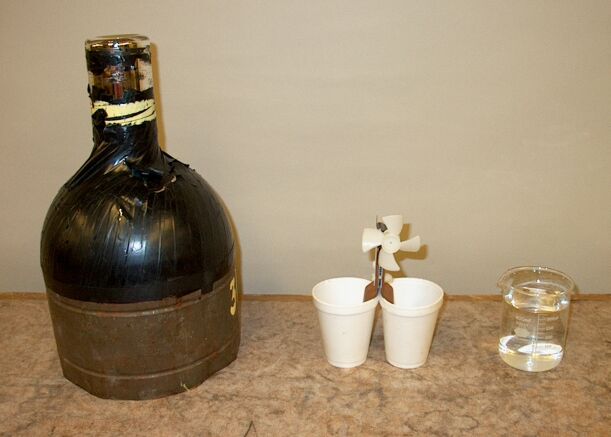

Pour liquid nitrogen into one cup, and room temperature water into the other cup. In about a minute the fan begins to turn, powered by the thermoelectric module (Peltier element).
Demonstration 52.41 – Peltier element, describes the workings of a Peltier element, also called a thermoelectric element or thermoelectric module. It presents the Peltier element as a heater or cooler, in which an electric current running through the device produces a temperature difference between its two faces. This is a manifestation of the Peltier effect, in which a current flowing through a thermocouple junction, in one direction causes the junction to heat, and in the opposite direction causes it to cool. In this thermoelectric fan demonstration, instead of running a current through the Peltier element to use it in this way, we put its two faces at different temperatures, and via the Seebeck effect, generate a potential difference across it. This potential difference is great enough to cause sufficient current to flow through the fan motor to spin the fan. The Peltier element is sandwiched between the two large copper heat sinks in the apparatus shown above. We put the two heat sinks at different temperatures by putting room-temperature water in one cup, and liquid nitrogen in the other. (We could also use room-temperature water in one cup and boiling water in the other.)
The Seebeck effect is named for Thomas Johann Seebeck, who discovered it in the early 1820s. The basis for this effect is that different metals have different densities of electrons in the conduction band, so that when you place two dissimilar metals firmly in contact with each other, some electrons flow from one metal into the other. The resulting charge imbalance gives rise to a small potential difference between them, the magnitude of which is temperature dependent (because the density of the electrons in the conduction band of each metal is temperature dependent). A junction formed with two dissimilar metals is called a thermocouple, and it can be used as the sensing element in a thermometer. The voltage across a single thermocouple is quite small, but one can increase it by connecting many thermocouples in series. One way to do this is to form an array of junctions alternating in polarity. In a device made of such an array, if all the junctions of one polarity are placed on one face, and all the junctions of opposite polarity are placed on the opposite face, then putting the two faces at different temperatures produces a potential difference between the two ends of the string of thermocouples. The direction of this potential difference depends on which face is at a higher temperature than the other. Switching which face is hotter than the other reverses the direction of the voltage across the device. In this demonstration, switching which cup holds the water and which cup holds the liquid nitrogen reverses the direction in which the fan spins.
The thermocouple junctions in most Peltier elements are actually semiconductor junctions of n-type and p-type bismuth telluride, antimony telluride and/or bismuth selenide.
References:
1) Sears, Francis Weston, and Zemanskey, Mark W. College Physics, Third Edition (Reading, Massachusetts: Addison-Wesley Publishing Company, Inc., 1960) pp. 601-5.
2) The Most Frequently Asked Questions about Thermoelectric Cooling
3) https://www.digikey.com/en/articles/choosing-using-advanced-peltier-modules-thermoelectric-cooling